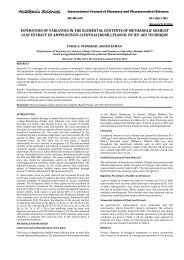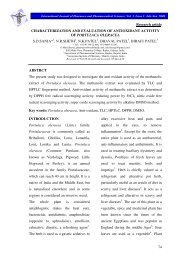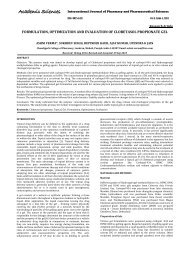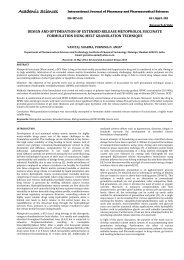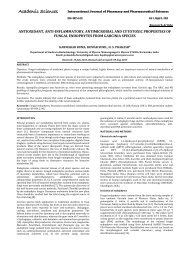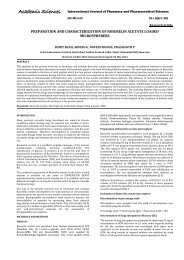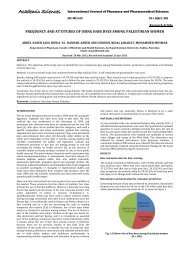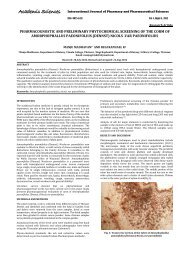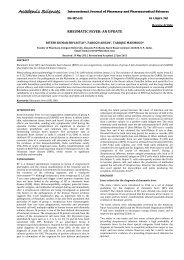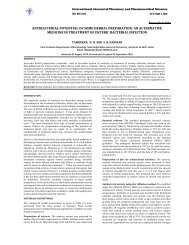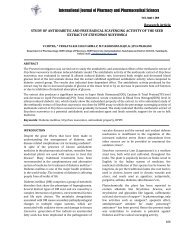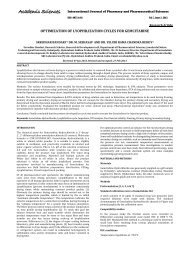hyperbaric oxygen therapy: a review - International Journal of ...
hyperbaric oxygen therapy: a review - International Journal of ...
hyperbaric oxygen therapy: a review - International Journal of ...
You also want an ePaper? Increase the reach of your titles
YUMPU automatically turns print PDFs into web optimized ePapers that Google loves.
Academic Sciences<br />
<strong>International</strong> <strong>Journal</strong> <strong>of</strong> Pharmacy and Pharmaceutical Sciences<br />
ISSN- 0975-1491 Vol 5, Issue 4, 2013<br />
HYPERBARIC OXYGEN THERAPY: A REVIEW<br />
Review Article<br />
1 THARANGINI RAVEENTHIRARAJA, 2 DR. M.SUBHA<br />
1<br />
Saveetha Dental College and hospital, Velapanchavadi, Chennai 600077, 2 Department <strong>of</strong> Oral Medicine and Radiology, Saveetha Dental<br />
College and hospital, Velapanchavadi, Chennai 600077. Email: doctorsubha@gmail.com<br />
ABSTRACT<br />
Received: 01 Aug 2013, Revised and Accepted: 22 Aug 2013<br />
Hyperbaric <strong>oxygen</strong> <strong>therapy</strong> (HBO) is an effective adjuvant <strong>therapy</strong> in conditions where normal healing is impaired. In HBO 100 per cent<strong>oxygen</strong> at<br />
two to three times the atmospheric pressure at sea level is administered and this result in arterial <strong>oxygen</strong> tension in excess <strong>of</strong> 2000 mm Hg and<br />
<strong>oxygen</strong> tension in tissue <strong>of</strong> almost 400mmHg. Oxygen doses <strong>of</strong> such have many beneficial biochemical cellular and physiologic effects .In this article<br />
we <strong>review</strong> the mechanism <strong>of</strong> action, uses and risks <strong>of</strong> <strong>hyperbaric</strong> <strong>oxygen</strong>.<br />
Keywords: Hyperbaric <strong>oxygen</strong> <strong>therapy</strong>, Wound healing, Decompression sickness, Gangrene.<br />
INTRODUCTION<br />
Hyperbaric <strong>oxygen</strong> has been described as “a <strong>therapy</strong> in search <strong>of</strong><br />
disease” [1]. In the past it did not have much scientific support but it<br />
had evolved a lot and is <strong>of</strong> extensive use in the field <strong>of</strong> medicine. This<br />
concept historically can be traced back to 1600. The first <strong>hyperbaric</strong><br />
chamber was constructed by British clergyman Henshaw [2]. He<br />
called the chamber domicilium. This chamber was pressurized and<br />
depressurized using bellows. Henshaw used his domicilium to<br />
facilitate digestion, to facilitate breathing, prevention <strong>of</strong> respiratory<br />
infections. This chamber provided only atmospheric air under high<br />
pressure as <strong>oxygen</strong> was not discovered till 1773 by Carl<br />
WilhemSheeley. The term <strong>oxygen</strong> was coined by Antoine Lavoiser<br />
only in 1777[2]. French surgeon Fontaine was the first to build a<br />
pressurized mobile operating room in 1879 [3]. He used Nitrous<br />
oxide as anesthetic agent and believed <strong>hyperbaric</strong> <strong>oxygen</strong> chambers<br />
helped in better patient anesthesia.Paul Bert (1878) demonstrated<br />
the physical and physiological principles, therapeutic applications<br />
and potential toxicity <strong>of</strong> <strong>oxygen</strong>. Then Bert (1878), Zuntz (1897) and<br />
Von Schrotter(1906) recommended the <strong>oxygen</strong> <strong>therapy</strong> for<br />
decompression sickness[4].Orwill Cunningham Pr<strong>of</strong>essor <strong>of</strong><br />
anesthesia (1928) ran a Hyperbaric <strong>oxygen</strong> hospital in Lawrence<br />
Kansas. He christened it as “Steel Ball Hospital”. This so called<br />
<strong>hyperbaric</strong> <strong>oxygen</strong> hospital was six stories high and 64 feet in<br />
diameter. This hospital could achieve pressure levels <strong>of</strong> 3<br />
atmospheres [3].From 1930 onwards <strong>oxygen</strong> supplementation was<br />
used to manage acute decompression sickness. Oxygen when<br />
respired at very high pressures manages to displace nitrogen<br />
accumulated from the tissue. Use <strong>of</strong> <strong>hyperbaric</strong> <strong>oxygen</strong> considerably<br />
helps to reduce the time taken to treat decompression sickness. In<br />
1935, Behnke showed nitrogen to be the common cause <strong>of</strong> narcosis<br />
in humans during decompression sickness. Behnke and Shaw<br />
successfully used <strong>hyperbaric</strong> <strong>oxygen</strong> to treat decompression<br />
sickness. The first medical use <strong>of</strong> HBO(adjuvant treatment at 3ATA)<br />
for decompression was given by Boerema(1959) during an open<br />
heart surgery[4]. Brummelkamp(1961) incorporated HBO <strong>therapy</strong><br />
in treatment protocol<strong>of</strong> gas gangrene[4]. After overcoming<br />
numerous problems like fires and explosions and the discovery <strong>of</strong><br />
the cellular and biochemical effect <strong>of</strong> administering <strong>hyperbaric</strong><br />
<strong>oxygen</strong> as primary <strong>therapy</strong> has increased in patients with severe<br />
carbon monoxide poisoning decompression sickness and arterial gas<br />
embolism, and as an adjunctive <strong>therapy</strong> for preventive and<br />
treatment <strong>of</strong> osteoradionecrosis, Clostridialmyonecrosis and<br />
comprised skin grafts flaps, promote healing by reducing edema and<br />
inflammation, augment microbial killing and involve cell<br />
mobilization [5], angiogenesis [6] and tissue repair[7].<br />
PRINCIPLE [4]<br />
Most applications <strong>of</strong> <strong>hyperbaric</strong> conditions and HBO <strong>therapy</strong> are<br />
derived directly from principles and laws <strong>of</strong> physics developed over<br />
centuries.<br />
1. Boyle’s law, the theory <strong>of</strong> compressibility states that at a<br />
constant temperature, the volume <strong>of</strong> gas is inversely<br />
proportional to pressure.<br />
2. Dalton’s law, the law <strong>of</strong> partial pressure states that pressure <strong>of</strong><br />
a gaseous mixture can be considered as the sum <strong>of</strong> partial<br />
pressures <strong>of</strong> its constituent gases,<br />
3. Henry’s law, explains pathogenesis <strong>of</strong> decompression sickness<br />
and role <strong>of</strong> <strong>hyperbaric</strong> <strong>oxygen</strong> in its treatment.<br />
EQUIPMENT [4, 8]<br />
There are two types <strong>of</strong> <strong>hyperbaric</strong> chambers, monoplace and<br />
multiplace chambers (Table 1). Monoplace chambers have a small<br />
air tight cylinder for patient placement. The chamber is then filled<br />
with pressurised pure <strong>oxygen</strong>. Only auditory and visual<br />
communication is possible and patient cannot be physically<br />
examined. In multiplace chambers several patients can be treated at<br />
the same time and the patient jus breaths the <strong>hyperbaric</strong> <strong>oxygen</strong><br />
through endotracheal tube or air tight mask and they can be<br />
clinically monitored by nurses or physicians throughout the<br />
procedure[4].<br />
Table 1: Features <strong>of</strong> monoplace and multiplace chamber<br />
Monoplace<br />
Multiplace<br />
Patient Claustrophobic environment limited access to patient. More room assistance to deal with some acute problems.<br />
Administration <strong>of</strong><br />
HBO<br />
Inhaled in the atmosphere or through an<br />
endotracheal tube in the monoplace chamber.<br />
Inhaled through mask, tight fitting hoods or endotracheal tubes in a<br />
larger multi-occupant chamber.<br />
Cost Lower cost. Higher cost.<br />
Infection Less spread <strong>of</strong> infection. Risk <strong>of</strong> cross infections when used for ulcers.<br />
Portability Portable more common worldwide. (5-32) Large device not portable.<br />
Treatment on<br />
patient<br />
Usually one patient at a time and is used to treat<br />
patients with chronic medical conditions.<br />
Required for critically ill patients who require an attendant within<br />
the chamber and is usually used for acute problems.<br />
Risk Increased risk <strong>of</strong> fire. Reduced risk <strong>of</strong> fire.
Subha et al.<br />
Int J Pharm Pharm Sci, Vol 5, Issue 4, 52-54<br />
MECHANISM OF ACTION OF HBO [4, 8, 9]<br />
Effect <strong>of</strong> pressure: Reduces volume <strong>of</strong> gas bubbles allows them to<br />
move freely through small blood vessels thereby reducing chances <strong>of</strong><br />
infarction. This effect helps in gas embolism and decompression<br />
sickness.<br />
Effect <strong>of</strong> increasing <strong>oxygen</strong> pressure: Administration <strong>of</strong> <strong>oxygen</strong> at<br />
high pressure helps in rapid elimination <strong>of</strong> toxic gases like carbon<br />
monoxide, hence used in treatment <strong>of</strong> carbon monoxide poisoning.<br />
Effect <strong>of</strong> reactive vasoconstriction: HBO acts as an alphaadrenergic<br />
agent this causes reactive vasoconstriction in small<br />
vessels thereby reducing vascularoedema without altering normal<br />
tissue <strong>oxygen</strong>ation. This property helps in management <strong>of</strong> severe<br />
crush injuries and thermal burns.<br />
Antibacterial effect: Most antibacterial defence mechanism are<br />
<strong>oxygen</strong> dependent, HBO optimizes anti-infective properties <strong>of</strong><br />
polymorphonuclear neutrophil through formation <strong>of</strong> enzymes and<br />
superoxide ions.<br />
Anti-ischemic effect: HBO <strong>therapy</strong> results in excess dissolved<br />
<strong>oxygen</strong> in blood also it increases deformability <strong>of</strong> red blood cells,<br />
which enable them to reach ischemic tissues.<br />
Healing effect: HBO promotes osteoclast and osteoblast growth,<br />
facilitates collagen synthesis stimulates angiogenesis hence used in<br />
management <strong>of</strong> refractory lesions, osteoradionecrosis, extensive<br />
burns and compromised grafts.<br />
INDICATIONS OF HBO [10, 11]<br />
Non-healing ulcers, wounds, compromised skin grafts and flaps:<br />
Wounds have tissue hypoxia with <strong>oxygen</strong> tension below 20mmhg,<br />
hence prone for infection. HBO increases <strong>oxygen</strong> tension which<br />
enhances leukocyte bacterial activity and promotes<br />
neovascularisation. Hence used as an adjuvant in ischemic foot<br />
ulcers, dehiscent amputation site, post-radiation ulcers [7, 8, 12]. It<br />
increases graft and flap survival and is also beneficial in occlusive<br />
arterial diseases <strong>of</strong> extremities[13,14]<br />
Acute traumatic ischemia (Crush injuries): These injuries may<br />
cause necrosis <strong>of</strong> a portion <strong>of</strong> the extremity or entire extremity<br />
which as a secondary complication can develop infection due to<br />
compromised circulation. HBO enhances <strong>oxygen</strong> tension, increases<br />
reperfusion by increasing <strong>oxygen</strong> delivery per unit <strong>of</strong> blood flow.<br />
Thus it acts as an effective adjuvant in managing these injuries[8,15].<br />
Clostridialmyonecrosis (Gas gangrene): Clostridium cannot<br />
produce alpha-toxins when HBO is administered as it elevates the<br />
<strong>oxygen</strong> tension; they never kill the organism nor detoxify alphatoxin<br />
but shuts <strong>of</strong>f toxin production within 30minutes. It is<br />
synergistic with antibiotics like aminoglycosides, quinolones, sulpha<br />
and amphotericinB. Hence in conditions like gas gangrene the<br />
treatment protocol includes antibiotic, surgery, HBO <strong>therapy</strong> [8,<br />
10,16].<br />
Necrotising s<strong>of</strong>t tissue infection: S<strong>of</strong>t tissue necrosis involves both<br />
aerobic and anaerobic organisms hence HBO acts as an adjuvant<br />
<strong>therapy</strong>. HBO enhances white cell killing <strong>of</strong> bacteria promotes<br />
inhibition <strong>of</strong> anaerobic organism growth [1, 8, 17].<br />
Late radiation tissue damage: Above 5000rads healing <strong>of</strong> wound is<br />
difficult because <strong>of</strong> progressive endarteritis which results in hypoxia<br />
and tissue ischemia. HBO induces neovascularisation which result in<br />
healing [3, 18].<br />
Thermal burns: They have zone <strong>of</strong> coagulation, surrounded by area<br />
<strong>of</strong> stasis, bound by hyperaemia. HBO reduces fluid retention,<br />
preserves marginal viable tissue, improves microvasculature, faster<br />
epithelialization, reduces inflammation, preserves tissue creatine<br />
phosphate and adenosine phosphate also decreases wound lactate<br />
thereby promoting healing[19].<br />
Carbon monoxide poisoning: HBO reduces half-life <strong>of</strong> carbon<br />
monoxide from 4 to 5 hours to 20 minutes hence prevents neuronal<br />
injury [8, 10,17].<br />
Refractory osteomyelitis: HBO increases <strong>oxygen</strong> tension which<br />
promotes angiogenesis, increasing leukocyte killing, aminoglycoside<br />
transport across bacterial cell wall and osteoclastic activity in<br />
removing necrotic bone [20, 21].<br />
Air embolism/Decompression sickness: Air embolism is caused<br />
by trauma. Decompression sickness is caused by nitrogen bubble<br />
formation in blood vessels. HBO reduces the size <strong>of</strong> the bubble and<br />
prevents infarction [4, 22].<br />
Severe blood loss anaemia: Patient who had severe blood loss and<br />
where blood transfusion is contraindicate intermittent HBO will help<br />
in <strong>oxygen</strong> supply for metabolic needs [23].<br />
Sudden deafness: Cochlear activity is sensitive in constant supply<br />
<strong>of</strong> <strong>oxygen</strong>. Hence an acute deafness can be improved by HBO <strong>therapy</strong><br />
along with hemodilution and vasoactive drugs[24].<br />
Table 2: Therapeutic doses <strong>of</strong> HBO [4, 17]<br />
Condition Dosage Duration<br />
Carbon Monoxide Poisoning 2.1 – 3.0 atmospheres 4 – 6 hours<br />
Decompression sickness 2.5 – 3.0 atmospheres 2 – 4 hours<br />
Arterial Gas Embolism 2.5 – 3.0 atmospheres 2 – 4 hours<br />
Radiation Induced Tissue Injury 2.4 atmospheres 90 minutes (30 preoperative sessions)<br />
(ORN)<br />
ClostridialMyonecrosis 3 atmospheres 90 minutes (with antibiotics and surgery)<br />
Necrotizing Fasciitis 3 atmospheres 90 minutes (with antibiotics and surgery)<br />
Refractory Osteomyelitis 2.0 – 2.5 atmospheres 90 – 120 minutes (after debridement and antibiotic <strong>therapy</strong>)<br />
Acute Traumatic Ischemic Injury 2.0 – 2.8 atmospheres 2 hours<br />
Anemia due to Exceptional Blood<br />
Loss<br />
Comprised skin grafts and Flaps 2.0 – 2.5 atmospheres 90 - 120 minutes<br />
Thermal Burns 2.0 – 2.5 atmospheres 90 – 120 minutes<br />
Hyperbaric <strong>oxygen</strong> used successfully to treat hemorrhagic shock in patients who refused transfusion or for<br />
whom suitable blood was not available.<br />
CONTRAINDICATIONS [4, 9]<br />
Absolute contraindication:<br />
Pneumothorax<br />
Relative contraindication:<br />
Upper respiratory tract infection<br />
Emphysema<br />
Seizure disorder<br />
<br />
<br />
<br />
<br />
<br />
<br />
<br />
Patients on high dose steroids<br />
Chronic obstruction pulmonary disorder<br />
Recent myocardial infraction<br />
History <strong>of</strong> recent ear or thoracic surgery<br />
Pregnancy<br />
Claustrophobia<br />
Uncontrolled hyperthermia.<br />
53
Subha et al.<br />
Int J Pharm Pharm Sci, Vol 5, Issue 4, 52-54<br />
DISADVANTAGES[4]<br />
1. Higher capitalization requirements.<br />
2. Major space requirements; basement and/or ground floor level<br />
limitations.<br />
3. Higher operating costs.<br />
4. Larger and experienced staffing requirements.<br />
5. Risk <strong>of</strong> decompression sickness in internal personnel.<br />
6. Facility fire-associated decompression requirements.<br />
7. Significant equipment maintenance and system upkeep<br />
requirements.<br />
8. Associated fire hazard with pure <strong>oxygen</strong> environment.<br />
9. Risk <strong>of</strong> <strong>oxygen</strong> toxicity as well as increased risk <strong>of</strong> complications<br />
from pneumothorax and/or tension pneumothorax and arterial<br />
air embolism developing during decompression.<br />
10. Permit requirements by FDA, local health department, and fire<br />
marshal.<br />
RISKS IN HBO THERAPY[8]<br />
1. Fire hazard which may be fatal.<br />
2. Barotrauma can lead to ear, sinus and lung damage.<br />
3. Oxygen toxicity brain and lung damage.<br />
SAFETY MEASURES [4]<br />
1. Should rule out contraindications.<br />
2. Proper training to the doctor.<br />
3. Minimum clinical monitoring should be provide.<br />
4. Electric circuit and chamber components should be checked<br />
periodically.<br />
5. Fire control system is required.<br />
CONCLUSION<br />
Though HBO <strong>therapy</strong> has lot <strong>of</strong> disadvantages and risks the benefits<br />
overweigh in using it. But clearer evidences are available for few<br />
diseases like decompression sickness and gas gangrene. Hence a lot<br />
<strong>of</strong> work is required to be done to establish the indication, dosage and<br />
duration <strong>of</strong> the <strong>therapy</strong>. Doctors need to be trained to administer<br />
this mode <strong>of</strong> management and more centres are required to make it<br />
a regular treatment modality as it has synergistic effects with the<br />
conventional treatment modalities.<br />
REFERENCES<br />
1. Gabb G, Robin ED. Hyperbaric <strong>oxygen</strong>: a <strong>therapy</strong> in search <strong>of</strong><br />
disease. Chest1987; 92: 473-83.<br />
2. Henshaw IN, Simpson A. Compressed Air as a Therapeutic<br />
Agent in the Treatment <strong>of</strong> Consumption, Asthma, Chronic<br />
Bronchitis and Other Diseases. Edinburgh: Sutherland and<br />
Knox; 1857.<br />
3. Kindwall E, Whelan H. Hyperbaric Medicine Practice. 2Nd ed.<br />
Flagstaff, AZ: Best Publishing Company; 2004.<br />
4. Hyperbaric <strong>oxygen</strong> <strong>therapy</strong> in Quebec. Montreal: AETMIS,<br />
2001,X-124.<br />
5. Thom SR, Bhopale VM, Veiazquez OC, et al: Stem cell<br />
mobilization by <strong>hyperbaric</strong> <strong>oxygen</strong>. Am J Physiol Heart<br />
CircPhysiol2006:290:H1378.<br />
6. Gallagher KA, Goldstein LJ, Thom SR, et al: Hyperbaric <strong>oxygen</strong><br />
and bone marrow derived endothelial progenitor cells in<br />
diabetic wound healing. Vascular2006:14:328.<br />
7. Boykin JV Jr, Baylis C: Hyperbaric <strong>oxygen</strong> <strong>therapy</strong> mediates<br />
increased nitric oxide production with wound healing: A<br />
preliminary study. Adv Skin Wound Care2007:20:382.<br />
8. R M Leach, P J Rees, P Wilmshurst. ABC <strong>of</strong> <strong>oxygen</strong>, Hyperbaric<br />
<strong>oxygen</strong> <strong>therapy</strong>. BMJ 0ct 1998: vol 317: (1140-1143).<br />
9. Lieutenant Sarah Sharkey. Current indications for <strong>hyperbaric</strong><br />
<strong>oxygen</strong> <strong>therapy</strong>. ADF HealthApril 2000: Vol 1.<br />
10. Hampson NB, ed.: Hyperbaric <strong>oxygen</strong> <strong>therapy</strong>: 1999 committee<br />
report. Kensington, MD: Undersea Hyperb Med Soc, 1999.<br />
11. T Sahni, P Singh, MJ John. Hyperbaric Oxygen Therapy: Current<br />
trends and applications. JAPIMar 2003: Vol. 51:280-284.<br />
12. Cohn GH. Hyperbaric <strong>oxygen</strong> <strong>therapy</strong>- promoting healing in<br />
difficult cases. Postgraduate Medicine1986;79:89-92.<br />
13. Kindwall EP, Gottlieb FJ, Larson DL. Hyperbaric <strong>oxygen</strong> <strong>therapy</strong><br />
in plastic surgery and reconstructive <strong>therapy</strong> 1991.<br />
14. Urayam H, Takemura H, Kasajima F, et al. Hyperbaric <strong>oxygen</strong><br />
<strong>therapy</strong> in chronic occlusive arterial diseases <strong>of</strong> the<br />
extremities. J JapneseSurg Soc. 1992:93; 429-33.<br />
15. Cramer FS. Care <strong>of</strong> injured soldiers: A medical readiness role<br />
for clinical <strong>hyperbaric</strong> <strong>oxygen</strong> <strong>therapy</strong>. Medical Corps<br />
<strong>International</strong>1990:5:36-40.<br />
16. Sahni TK, John MJ, Madhwal AM, et al. Hyperbaric <strong>oxygen</strong><br />
<strong>therapy</strong> in hospital practice. Bombay Hosp J. 1993:35:59-64.<br />
17. Tibble PM, Edelberg JS. Hyperbaric <strong>oxygen</strong> <strong>therapy</strong>.<br />
NEJM1996:1642-8.<br />
18. Dampsey J et al. Cost effectiveness analysis <strong>of</strong> <strong>hyperbaric</strong><br />
<strong>therapy</strong> in osteonecrosis. Can JPlast Surg.1997:5:221-9.<br />
19. Cianci P, Sato R. Adjunctive <strong>hyperbaric</strong> <strong>oxygen</strong> <strong>therapy</strong> in the<br />
treatment <strong>of</strong> thermal burns.A <strong>review</strong>. Burns 1994:20:5-14.<br />
20. Calhoun JH, Cobos JA, Mader JT. Does <strong>hyperbaric</strong> <strong>oxygen</strong> have a<br />
place in treatment <strong>of</strong> osteomyelitis? OrthopedicClin North<br />
Am1991:22:467-71.<br />
21. Tenhey JE, Davis JC, Workman WT. Hyperbaric <strong>oxygen</strong> <strong>therapy</strong>.<br />
Ortho Rev:XIV:1987:829-33.<br />
22. Carton PW, Dutka AJ, Biondi DM, et al. Cerebral air embolism<br />
treated by pressure and <strong>hyperbaric</strong> <strong>oxygen</strong>.Neurology<br />
1991:41:314-5.<br />
23. Hart GB. Exceptional blood loss anaemia treated by <strong>hyperbaric</strong><br />
<strong>oxygen</strong>. JAMA1974: 228: 1028-9.<br />
24. Lamm K, Lamm H, Arnold W. Effect <strong>of</strong> <strong>hyperbaric</strong> <strong>oxygen</strong><br />
<strong>therapy</strong> in comparison to conventional or placebo <strong>therapy</strong> or<br />
no treatment in idiopathic sudden hearing loss, acoustic<br />
trauma, noiseinduced hearing loss and tinnitus. A literature<br />
survey. AdvOtorhinolaryngology1998:54: 86-99.<br />
54



